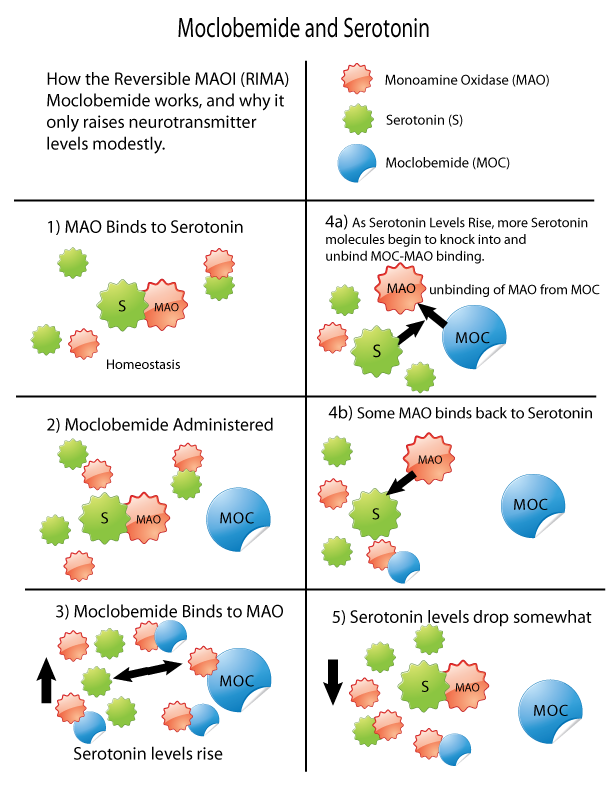|
Clorgyline
Clorgiline (INN), or clorgyline ( BAN), is a monoamine oxidase inhibitor (MAOI) structurally related to pargyline which is described as an antidepressant. Specifically, it is an irreversible and selective inhibitor of monoamine oxidase A (MAO-A). Clorgiline was never marketed, but it has found use in scientific research. It has been found to bind with high affinity to the σ1 receptor (Ki = 3.2 nM) and with very high affinity to the I2 imidazoline receptor (Ki = 40 pM). Unlike selegiline, clorgiline does not appear to be a monoaminergic activity enhancer Monoaminergic activity enhancers (MAE), also known as catecholaminergic/serotonergic activity enhancers (CAE/SAE), are a class of drugs that enhance the action potential-evoked release of monoamine neurotransmitters in the nervous system. MAEs ar ... (MAE). Clorgiline is also a multidrug efflux pump inhibitor. Holmes ''et al.'', 2012 reverse azole fungicide resistance using clorgiline, showing promise for its u ... [...More Info...] [...Related Items...] OR: [Wikipedia] [Google] [Baidu] |
Pargyline
Pargyline, sold under the brand name Eutonyl among others, is a monoamine oxidase inhibitor (MAOI) medication which has been used to treat hypertension (high blood pressure) but is no longer marketed. It has also been studied as an antidepressant, but was never licensed for use in the treatment of depression. The drug is taken by mouth. Side effects of pargyline include orthostatic hypotension among others. It has the potential for serious food and drug interactions with sympathomimetic agents like tyramine that can result in hypertensive crisis. Pargyline acts as a non-selective and irreversible inhibitor of the monoamine oxidases MAO-A and MAO-B. The exact mechanism of the hypotensive effects of pargyline and other MAOIs is unclear. Structurally, pargyline is a benzylamine derivative and is related to selegiline and clorgyline. Pargyline was first described in 1960 and was introduced for medical use in 1963. It was available in the United States and the United Kingdom. ... [...More Info...] [...Related Items...] OR: [Wikipedia] [Google] [Baidu] |
Monoamine Oxidase A
Monoamine oxidase A, also known as MAO-A, is an enzyme ( E.C. 1.4.3.4) that in humans is encoded by the ''MAOA'' gene. This gene is one of two neighboring gene family members that encode mitochondrial enzymes which catalyze the oxidative deamination of amines, such as norepinephrine, serotonin and tyramine. A mutation of this gene results in Brunner syndrome. This gene has also been associated with a variety of other psychiatric disorders, including antisocial behavior. Alternatively spliced transcript variants encoding multiple isoforms have been observed. Structures Gene Monoamine oxidase A, also known as MAO-A, is an enzyme that in humans is encoded by the ''MAOA'' gene. The promoter of ''MAOA'' contains conserved binding sites for Sp1, GATA2, and TBP. This gene is adjacent to a related gene ('' MAOB'') on the opposite strand of the X chromosome. In humans, there is a 30-base repeat sequence repeated several different numbers of times in the promoter re ... [...More Info...] [...Related Items...] OR: [Wikipedia] [Google] [Baidu] |
Azole Fungicide Resistance
Azoles are a class of five-membered heterocyclic compounds containing a nitrogen atom and at least one other non-carbon atom (i.e. nitrogen, sulfur, or oxygen) as part of the ring. Their names originate from the Hantzsch–Widman nomenclature. The parent compounds are aromatic and have two double bonds; there are successively reduced analogs (azolines and azolidines) with fewer. One, and only one, lone pair of electrons from each heteroatom in the ring is part of the aromatic bonding in an azole. Names of azoles maintain the prefix upon reduction (e.g., pyrazoline, pyrazolidine). The numbering of ring atoms in azoles starts with the heteroatom that is not part of a double bond, and then proceeds towards the other heteroatom. Imidazole and other five-membered aromatic heterocyclic systems with two nitrogens are extremely common in nature and form the core of many biomolecules, such as histidine. Compound classes ;Nitrogen only Imidazol.svg, Imidazole Pyrazol.svg, Pyrazole 1, ... [...More Info...] [...Related Items...] OR: [Wikipedia] [Google] [Baidu] |
Monoamine Oxidase Inhibitors
Monoamine oxidase inhibitors (MAOIs) are a class of drugs that inhibit the activity of one or both monoamine oxidase enzymes: monoamine oxidase A (MAO-A) and monoamine oxidase B (MAO-B). They are best known as effective antidepressants, especially for treatment-resistant depression and atypical depression. They are also used to treat panic disorder, social anxiety disorder, Parkinson's disease, and several other disorders. Reversible inhibitors of monoamine oxidase A (RIMAs) are a subclass of MAOIs that selectively and reversibly inhibit the MAO-A enzyme. RIMAs are used clinically in the treatment of depression and dysthymia. Due to their reversibility, they are safer in single-drug overdose than the older, irreversible MAOIs, and weaker in increasing the monoamines important in depressive disorder. RIMAs have not gained widespread market share in the United States. Medical uses MAOIs have been found to be effective in the treatment of panic disorder with agoraphob ... [...More Info...] [...Related Items...] OR: [Wikipedia] [Google] [Baidu] |
Imidazoline Receptor Modulators
Imidazoline is a heterocycle formally derived from imidazole by the reduction of one of the two double bonds. Three isomers are known, 2-imidazolines, 3-imidazolines, and 4-imidazolines. The 2- and 3-imidazolines contain an imine center, whereas the 4-imidazolines contain an alkene group. The 2-Imidazoline 2-Imidazoline (Preferred IUPAC name: 4,5-dihydro-1''H''-imidazole) is one of three isomers of the nitrogen-containing heterocyclic compound, heterocycle imidazoline, with the formula C3H6N2. The 2-imidazolines are the most common imidazolines comm ... group occurs in several drugs.Liu, H. and Du, D.-M. (2009), Recent Advances in the Synthesis of 2-Imidazolines and Their Applications in Homogeneous Catalysis. Adv. Synth. Catal., 351: 489–519. doi: 10.1002/adsc.200800797 References {{Organic-chemistry-stub ... [...More Info...] [...Related Items...] OR: [Wikipedia] [Google] [Baidu] |
Chloroarenes
In organic chemistry, an aryl halide (also known as a haloarene) is an aromatic compound in which one or more hydrogen atoms directly bonded to an aromatic ring are replaced by a halide ion (such as fluorine F''−'', chlorine Cl−1,−3,−5, bromine Br−1, or iodine I−). Aryl halides are distinct from haloalkanes (alkyl halides) due to significant differences in their methods of preparation, chemical reactivity, and physical properties. The most common and important members of this class are aryl chlorides, but the group encompasses a wide range of derivatives with diverse applications in organic synthesis, pharmaceuticals, and materials science. Classification according to halide Aryl fluorides Aryl fluorides are used as synthetic intermediates, e.g. for the preparation of pharmaceuticals, pesticides, and liquid crystals. The conversion of diazonium salts is a well established route to aryl fluorides. Thus, anilines are precursors to aryl fluorides. In the classic Schiemann ... [...More Info...] [...Related Items...] OR: [Wikipedia] [Google] [Baidu] |
Amines
In chemistry, amines (, ) are organic compounds that contain carbon-nitrogen bonds. Amines are formed when one or more hydrogen atoms in ammonia are replaced by alkyl or aryl groups. The nitrogen atom in an amine possesses a lone pair of electrons. Amines can also exist as hetero cyclic compounds. Aniline is the simplest aromatic amine, consisting of a benzene ring bonded to an amino group. Amines are classified into three types: primary (1°), secondary (2°), and tertiary (3°) amines. Primary amines (1°) contain one alkyl or aryl substituent and have the general formula RNH2. Secondary amines (2°) have two alkyl or aryl groups attached to the nitrogen atom, with the general formula R2NH. Tertiary amines (3°) contain three substituent groups bonded to the nitrogen atom, and are represented by the formula R3N. The functional group present in primary amines is called the amino group. Classification of amines Amines can be classified according to the nature and number o ... [...More Info...] [...Related Items...] OR: [Wikipedia] [Google] [Baidu] |
Propargyl Compounds
In organic chemistry, the propargyl group is a functional group of 2- propynyl with the structure . It is an alkyl group derived from propyne (). The term propargylic refers to a saturated position ( ''sp''3-hybridized) on a molecular framework next to an alkynyl group. The name comes from mix of ''propene'' and ''argentum'', which refers to the typical reaction of the terminal alkynes with silver salts. The term homopropargylic designates in the same manner * a saturated position on a molecular framework next to a propargylic group and thus two bonds from an alkyne moiety. * a 3-butynyl fragment, , or substituted homologue. See also * Alkenyl groups ** Allyl ** Vinyl group * Ethynyl * Propargyl chloride * Propargyl alcohol * Propargyl bromide * Propiolic acid Propiolic acid is the organic compound with the formula HC2CO2H. It is the simplest acetylenic carboxylic acid. It is a colourless liquid that crystallises to give silky crystals. Near its boiling point, it deco ... [...More Info...] [...Related Items...] OR: [Wikipedia] [Google] [Baidu] |
Abandoned Drugs
Abandon, abandoned, or abandonment may refer to: Common uses * Abandonment (emotional), a subjective emotional state in which people feel undesired, left behind, insecure, or discarded * Abandonment (legal), a legal term regarding property ** Child abandonment, the extralegal abandonment of children ** Lost, mislaid, and abandoned property, legal status of property after abandonment and rediscovery * Abandonment (mysticism) Art, entertainment, and media Film * ''Abandon'' (film), a 2002 film starring Katie Holmes * ''Abandoned'' (1949 film), starring Dennis O'Keefe * ''Abandoned'' (1955 film), the English language title of the Italian war film ''Gli Sbandati'' * ''Abandoned'' (2001 film), a Hungarian film * ''Abandoned'' (2010 film), starring Brittany Murphy * ''Abandoned'' (2015 film), a television movie about the shipwreck of the ''Rose-Noëlle'' in 1989 * ''Abandoned'' (2022 film), starring Emma Roberts * ''The Abandoned'' (1945 film), a 1945 Mexican film * ''The Aba ... [...More Info...] [...Related Items...] OR: [Wikipedia] [Google] [Baidu] |
American Society For Microbiology
The American Society for Microbiology (ASM), originally the Society of American Bacteriologists, is a professional organization for scientists who study viruses, bacteria, fungi, algae, and protozoa as well as other aspects of microbiology. It was founded in 1899. The Society publishes a variety of scientific journals, textbooks, and other educational materials related to microbiology and infectious diseases. ASM organizes annual meetings, as well as workshops and professional development opportunities for its members. History ASM was founded in 1899 under the name the "Society of American Bacteriologists." In December 1960, it was renamed the "American Society for Microbiology." Mission ASM's mission is "to promote and advance the microbial sciences." The society seeks to accomplish this mission through: * Publishing highly cited publications * Running multi-disciplinary meetings * Deploying resources and expertise around the world * Advocating for scientific research * Fosteri ... [...More Info...] [...Related Items...] OR: [Wikipedia] [Google] [Baidu] |
Biochemical Society
The Biochemical Society is a learned society in the United Kingdom in the field of biochemistry, including all the cellular and molecular biosciences. It was founded in 1911 and acquired the existing '' Biochemical Journal'' the following year. The society additionally publishes the journals '' Clinical Science'' and '' Biochemical Society Transactions'' via its publishing arm, Portland Press. It awards the Colworth Medal and formerly awarded the CIBA Medal (Novartis Medal). As of 2024, the president is Julia Goodfellow. Structure As of December 2023, the society had over 4,500 members, mainly in the UK. It is affiliated with the European body, Federation of European Biochemical Societies (FEBS). The president has been Julia Goodfellow since 2022. The Society's headquarters are in London. History The society was founded in 1911, under the name of the Biochemical Club.Lemmon, Mark A. (2022). Prosperous Future. '' Journal of Biochemistry'' 172 (3): 129–130 R. H. A. Plimmer ... [...More Info...] [...Related Items...] OR: [Wikipedia] [Google] [Baidu] |


